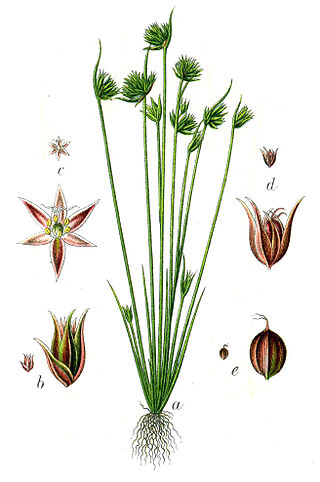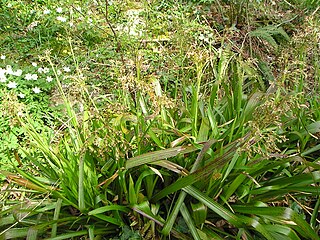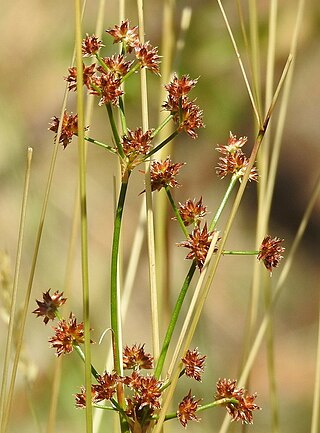
Juncaceae is a family of flowering plants, commonly known as the rush family. It consists of 8 genera and about 464 known species of slow-growing, rhizomatous, herbaceous monocotyledonous plants that may superficially resemble grasses and sedges. They often grow on infertile soils in a wide range of moisture conditions. The best-known and largest genus is Juncus. Most of the Juncus species grow exclusively in wetland habitats. A few rushes, such as Juncus bufonius are annuals, but most are perennials.

Juncus is a genus of monocotyledonous flowering plants, commonly known as rushes. It is the largest genus in the family Juncaceae, containing around 300 species.

Juncus effusus is a perennial herbaceous flowering plant species in the rush family Juncaceae, with the common names common rush or soft rush. In North America, the common name soft rush also refers to Juncus interior.

Juncus acutus, the spiny rush, sharp rush or sharp-pointed rush, is a flowering plant in the monocot family Juncaceae. It is native to the Americas, Northern and Southern Africa, Western and Southern Europe and West Asia, and is found in a variety of wet habitats, such as bogs, fens, meadows, and salt marshes, and along the edges of ponds and lakes.

Juncus articulatus is a flowering plant species in the rush family Juncaceae. It is known by the common name jointleaf rush or jointed rush, which can also refer to J. kraussii from Australia. It is native to Eurasia, Canada, Greenland, and much of the United States. It grows in moist areas, such as wet sand, and thrives in calcareous soils. J. articulatus was found to be more sensitive to drought and salt stress than its congeners J. acutus and J. maritimus. It is a perennial herb producing mainly erect stems from a short rhizome. The stem may root at nodes, and it generally has one or more flattened hollow cylindrical leaves up to 10 centimeters long. Transverse internal partitions or joints may be seen or felt in the leaf of the plant.

Juncus capitatus is a species of rush known by the common names dwarf rush and leafybract dwarf rush. It is native to Europe, Asia and North Africa. It is also an introduced species in parts of North America such as California and the Gulf Coast. It grows in moist areas, such as wet sand, vernal pools, and ditches.

In botany and ecology, graminoid refers to a herbaceous plant with a grass-like morphology, i.e. elongated culms with long, blade-like leaves. They are contrasted to forbs, herbaceous plants without grass-like features.

Luzula sylvatica, commonly known as greater wood-rush or great wood-rush, is a perennial flowering plant in the rush family Juncaceae.

Luzula multiflora, the common woodrush or heath wood-rush, is a species of flowering plant in the rush family.

Juncus acutiflorus, also called sharp-flowered rush, is a rush or a grassy plant of the genus Juncus. As the name suggests, the plant has notable sharp-looking flowers, flowering between July and September.
Luzula nivalis, commonly known as arctic wood-rush or less commonly as snowy wood-rush, is a species of perennial rush native to the North American Arctic and Northern Europe. It was described by Polunin (1940) as one of the most abundant, ubiquitous, and ecologically important of all arctic plants.

Juncus dichotomus is a monocot in the Juncaceae family of rushes. The plant is native to the Americas in temperate zones but has been introduced to other parts of the world. Juncus dichotomus often is found in very moist areas and where rainfall is a common occurrence. It is often most recognizable in the spring and summer months due to its conspicuous flowers and infructescence.

Juncus australis is a species of rush known by the common names austral rush, leafless rush and wīwī. The species is native to south-eastern Australia and New Zealand, where it can be found around bodies of water. Its habitat is wet or seasonally wet grasslands and woodlands, and it can grow in dense and damp soil along rivers and creeks. It is a rhizomatous perennial rush that grows up to 120 centimetres tall. The plant flowers in clusters, with dense heads at the tip of the stem.

Juncus inflexus, the hard rush, is a species of flowering plant in the family Juncaceae, native to Europe, Asia and Africa, and introduced in Sri Lanka, Java, Île Amsterdam and Île Saint-Paul, Victoria in Australia, New Zealand, Uruguay, and eastern North America. It is a glycophyte (non-halophyte).

Juncus scirpoides, the needlepod rush, is a species of flowering plant in the family Juncaceae, native to the central and eastern United States. It prefers wet sandy soils, and among the many places it grows it is common in the enigmatic Carolina bays.
Juncus sect. Tenageia is a section of small annual rushes.

Juncus heldreichianus is a large tufted species of rush in the family Juncaceae, formed of two subspecies.

Juncus fontanesii, also known as Desfontaines' rush, is a species of rush in the family Juncaceae.
Juncus littoralis is a species of rush in the family Juncaceae known as coastal rush; it has no subspecies.














